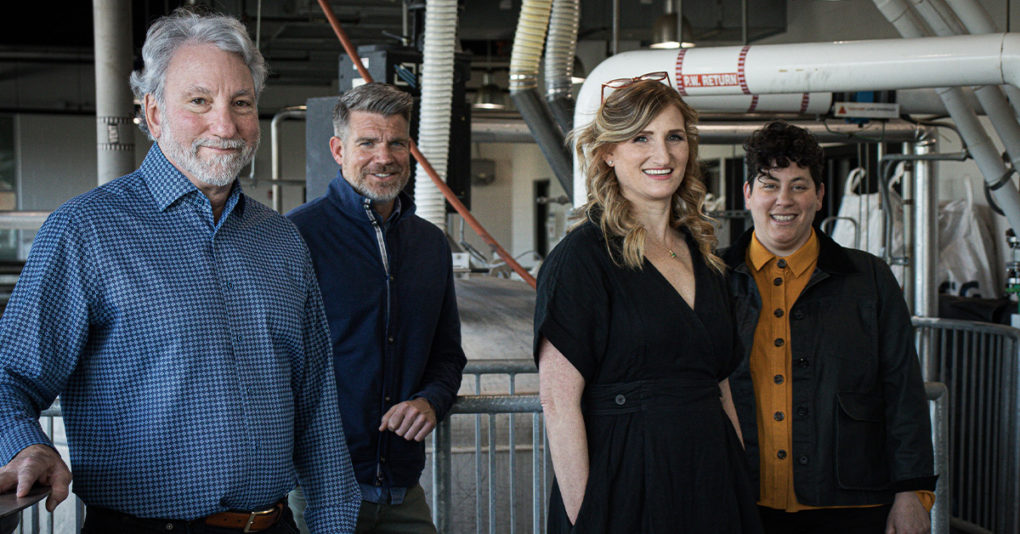
Yet New Riff’s story is far from over: the distillery, now managed by several long-time employees, increased its production capacity by 50% in 2021, while building its distribution to 29 states with more to come this year. But Lewis prides himself on building a great “small” distillery, so before he hung up his hat we chatted with him about why he believes small is better, how the bourbon boom’s consequences have caught up to producers, and the best career advice he offers other founders.
How has the whiskey business evolved since you started?
Well, it’s been fifty years, so what hasn’t evolved? In the ‘70s everything was relational and personal (as opposed to our current transactional). Salesmen actually sold, brands were built one-on-one based on criteria specific to that brand, and I, as a retailer, was close up and personal with my customers. The industry had personality not data points.
Without the internet or email, everything moved so much slower; I don’t think I knew the term “multi-tasking.” There was also trust in the system, not to mention trust and – get this — respect and appreciation for the people (in general) you did business with.
What do you see as some of the biggest challenges for the industry now, and what’s the biggest challenge New Riff is facing?
I believe the industry, particularly in Kentucky, is over-building and churning out far more barrels than will be reasonably absorbed upon their maturation. The “bourbon boom” is over and way too many people in the industry have financial reasons not to act on that fact. That doesn’t mean, at all, that bourbon is dying, far from it, but the “boom” has peaked and overproduction, coupled with the upheaval in the distribution ranks and the high interest rates which encourage “de-inventorying” at both distribution and retail levels, means that sales are in the second year of tightening.
I believe that New Riff has a solid niche as we prepare to celebrate our 10th anniversary. We are properly priced for a premium product and have an outstanding reputation for quality and doing everything right. I believe we will be okay in the shakeout that is just now beginning. But I wouldn’t want to be a non-distillery producer or any brand owner without a properly priced and positioned brand with an authentic story! The era of $80 two-year-olds with a pretty label is over — and I can’t say I’ll miss that.
Your story says you set out to become one of the great small distilleries of the world— why small and did that mission evolve?
I’m a ‘60s and ’70s guy, and I believe with all my heart that small is better. At one point in my retailing career, I had six stores and 350 employees and I hated being so “corporate” enough that I sold five of the six and focused solely on The Party Source in Northern Kentucky (which, to my surprise, in two years generated as much profit as six combined!) When you have venture capital or financial partners of any kind, or seek the highest financial return, there is an inevitable compromise between profitability and quality.
Our mission statement, from the very beginning, states that we wish to become one of the great small distilleries of the world, and deliberately eschews the sole pursuit of profits. Pick a side. You can’t make great whiskey and price it so ordinary whiskey lovers can afford it and maximize profitability. I also don’t believe you can rally your employees and all your stakeholders to achieve greatness if your banner is actually to “make me as much money as possible.”
How has the tasting room and tourism experience expanded over the years and how important is it to the business?
We just finished a $3 million dollar rebuild and re-imagination of our visitor center and gift shop, and turned our event center into a beautiful, upscale tasting room/bar called The Aquifer. All our direct-to-consumer activities are thriving, including our tours and private single barrel sales and, part of being a “smallish” distillery, getting us close to our customers and engaging with them in a variety of experiences. This is how we survive and prosper during the shakeout that has begun — and is the advantage of a distillery with an authentic story and, dare I say, a cachet and even a value infused “soul” compared to global giants that dominate our industry. Those personal interactions with our customers and finding genuine ways to do that with our branding and marketing as well as sharing experiences in person is the slingshot of David versus Goliath.
What are some of the strategies you are most proud of that distinguished New Riff from other distilleries?
I’m most proud of being determined to remain independent and family owned with no outside money creating external pressures on the distillery. This allows us to plan and execute on a very long-term basis and to be laser focused on quality and building the brand for future generations. It’s not about selling out for a big gain but only about becoming one of the great small distilleries of the world.
What’s the best advice you received in your career?
Somewhere along the way I picked up the following management “mantra” that has always informed New Riff: Hire the best people, define the mission clearly, give them the best tools, get the hell out of their way.